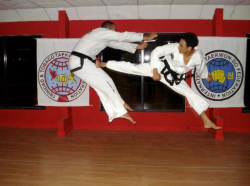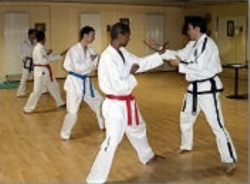Student Booklet - 8th KUP exam (Yellow belt)
Student booklet /
Main Menu
Student Booklet - 8th KUP exam (Yellow belt)
Exam 8th Kup
Student booklet
Select the level of the exam or the full booklet in the following box to have the theory you require :
Chon-Ji Historical background (TAEKWONDO YOKSA) for 8th KUP exam
"CHON-JI" literally means "heaven and earth". It is interpreted in the East as the creation of the world and the beginning of human history. Therefore this first Tul performed by beginners.
The Tul consists of two parts, the first part for heaven and the second for the earth. It contains 19 moves!
REMEMBER at the end : Bring the left foot back to NARANI SOGI
Back to top of page - Back to Welcome Page
Meaning of the yellow belt ( Ti ) - 8th Kup
The yellow belt means the earth from which the plant takes root and sprouts as the Taekwondo foundation is laid.
Back to top of page - Back to Welcome Page
Knowledge of Taekwondo for 8th KUP
The magic number 9:
One starts with 9th kup and ends 9th Dan in Taekwondo because 9 is a magic number for the Asians.
Multiply it by any other number, and the sum of the digits of the result is always 9. Ex.: 9 x 112 = 1008 the sum of digits: 1 + 0 + 0 + 8 = 9.
The number 9 in the East is an important sacred number. Moreover, it is mysterious, because it keeps coming back.
Sparring
A Taekwondo fight on competition will be decided by points and takes two minutes. There are four corner referees who give points and one ring referee on the field provided.
Point allocation
In sparring, the points are allocated as here below :
- 1 point for all fist techniques on the body or face
- 2 points for all leg techniques on the body
- 3 points for all leg techniques on the face
Warnings:
- Ui Ju Hanna: before a warning is given, the fight is stopped (= heachyo) and then a warning is attributed to the accused person. After three warnings, one point is deducted.
- Gam Jum Hanna: you can get a minus point through full contact (too hard, usually uncontrolled), falling down or ignoring umpire commands. Three direct minus points means disqualification (Sil Kyuk).
You get a warning by :
- Pushing
- Kicking below the belt
- Grabbing opponent
- Performing a technique on the back
- Deliberately avoiding battle (running away)
- Falling down (touch by hand on ground)
- Going out of the ring
- Attacking without looking
- turning away
- talking
- Claiming provoking point
Back to top of page - Back to Welcome Page
Matsogi (step sparring)
Taekwondo students learn the techniques of Matsogi. Those are taught with the movements from the tuls to learn how to apply them in sparring.
There are three types of Matsogi: Sambo Matsogi (three step sparring), Ibo Matsogi (two-step sparring) and Il- bo Matsogi (one step sparring).
For the yellow belt exam, candidates must perform five three steps. This is done in pairs.
Methodology
You stand facing each other, bow to each other, then the attacker (pre-arranged) measures the distance needed to perform the attack. After that, the attacker goes backward with his right leg in gunnun sogi najunde bakat palmok makgi. This is the initial position in which each three-step is carried out.
In theory, the defender determines which attack will be performed, but for practical reasons (on the distance between the performers), we recommend that the attacker decides which attack he will be performing. After all, the defender knows beforehand what technique the attacker will use).
Once the attacker has called the technique, he states that he is ready to attack ("TSE"). The defender ponders what technique he will use to defend and indicates that he is ready ("TSE"). The defender may take his time to get prepared for.
Afterwards the attacker kicks or punches and the defender defends/blocks three times. The defender then performs a counterattack.
Then reverse roles. The attacker brings his front leg back to NARANI SOGI (ie backwards) and the defender brings his back leg forward to NARANI SOGI. Now it's up to the person who has just defended for to attack.
Attention to:
It is important to set the feet in the right place. In an attack in niunja sogi, the attacker's feet are placed on the outside of the feet of the defender. If an attack is in gunnun sogi the foot of the attacker is placed on the right side of the foot of the defender, so first on the outside and second time on the inside.
The defender performs a counterattack depending on the distance between the two people. If the distance is large then a kicking technique can be used; it is recommended to have a hand technique at a short distance.
Back to top of page - Back to Welcome Page
Vocabulary for 8th KUP
| Korean | English |
|---|---|
| DWIRO OMGYO DIDIMYO DOLGI | Backward step turn (rotation Chon-Ji) |
| MIKULGI | Sliding on long distance |
| JAJUN BAL | Sliding on short distance - foot shifting |
Back to top of page - Back to Welcome Page
Hand-Technique for 8th KUP
| Korean | English |
|---|---|
| AN PALMOK BANDAE MAKGI | Forearm middle reverse block (Bandae because of the Niunja Sogi stance) |
Back to top of page - Back to Welcome Page
NIUNJA SOGI - L-Stance
This position is widely used in the defense, but for the offensive stand also useful. The front foot is in place to give a kick.
It only needs a small displacement of body weight to Make a niunja sogi. Move one foot forward or backwards, so that the length between both feet is slightly less than about a shoulder width
There is pretty much a straight-line corner formed. It is recommended to move both feet to about 15 degrees to point inside, this gives better stability.
Bend the back leg until the knee is in a straight vertical line with the toes, ditto the front leg. Make sure that the hip stays in line with the inner knee joint. The body weight distribution is 70 percent on the back leg and 30 percent on the front leg.
Grading to the 8th Kup (Yellow Belt)
- All knowledge from previous level
- Meaning of Chon-Ji Tul
- Meaning of Yellow belt
- To name (in Korean) all learned punches, blocks, kicks and stances, to show them and explain
- Correctly perform SAJU JIRUGI (4 direction punch)
- Correctly perform SAJU MAKGI (4 directions block)
- Correctly perform Chon-Ji Tul
- Correctly perform 5 different Sambo Matsogi's (three step sparring)
- To be able fight with partner for 2 min to demonstrate the different learned techniques.
Back to top of page - Back to Welcome Page


